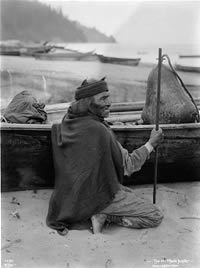
A History of Treaties and Reservations on the
Olympic Peninsula, 1855-1898
A Curriculum Project for Washington Schools
Developed by
Tim Wright
Olympic Peninsula Community Museum
in partnership with
the University Libraries,
Center for the Study of the Pacific Northwest,
and
University of Washington Department of History
Table of Contents
|
II. Historical Context and American Policy III. History of Treaty Making and Reservations on the Olympic Peninsula |
VI. Suggested Learning Activities |
I. Introduction
The curriculum materials in this packet are intended to provide middle- and high-school teachers with the background and basic tools they need to develop and incorporate lessons about Indian-white relations in Washington into existing lessons about the history of the United States and Washington. This packet focuses on the treaty negotiations and the establishment of reservations on the Olympic Peninsula that took place in the last half of the 19th century, but it also provides a broad overview of how relations between Indian nations and the United States government evolved in the first hundred years of the nation's history.
In brief, long before the United States emerged from the American Revolution, and long before Europeans sailed into the waters off the coast of what is now the state of Washington, the Olympic Peninsula was populated by peoples with complex cultures living within discrete territories and who had well-defined ideas of property and ownership. Although their lands were not mapped out in a modern, conventional fashion, the borders between tribes such as the Makah, Quileute, and Hoh were well known to the people living there. With the arrival of the Europeans and, later, Americans, the Native ideas of landholding came into conflict with Euroamerican ideas that were substantially different. The struggle and negotiation over territorial possession would define Indian-American relations in Washington from the mid-nineteenth century forward. It is a struggle that, in many respects, continues today. This curriculum guide will take a look at a part of that story: the treaties and negotiations that lead to the creation of the reservations of the Makah, Quileute, and Hoh. It aims to put the process into the context of then-current national ideas about Indian lands and sovereignty as well examine how those ideas played out in the earliest days of the Washington Territory. Using the primary source materials, students will be able to understand the broad outlines of the policies that framed Native-U.S. relations in the first years of Washington Territory, why treaties were established between the Natives of the Olympic peninsula and the U.S. government, how this negotiation process took place, and some of the reasons for friction between Natives and the early American settlers.
The contents in this curriculum packet can be grouped into three parts. First is the historical overview (Section II) that provides the national context that guided the development of the U.S.-Indian policies and shaped the treaties and the establishment of reservations on the Olympic Peninsula. This section is provided as background for teachers who may be unfamiliar with some of the broad outlines of U.S. Indian policy. The second part (Section III) is the story about how treaties were negotiated with Makah, Quileute, and Hoh and how the reservations were established on the peninsula in the nineteenth century. This section is the core element of the curriculum packet and is essential reading for those who want to understand what happened on the Olympic Peninsula in the last half of the nineteenth century. The third part (Sections IV-VI) covers the materials, resources and suggested learning activities that teachers and students can use in developing their lessons. These materials include copies of the treaties, documents, reports, maps, and photographs and they can be used in a variety of ways. Although the packet provides suggested learning activities, it is understood that teachers will pick and choose the best and most appropriate materials for their classes.